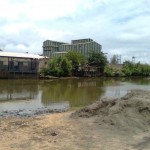Last week I mentioned how China controls of most world’s production of rare earth metals was dangerous! One comment received was about an American company, Quest Rare Minerals, which is developing a site in Canada called Strange Lake and in fact, there is a worldwide scramble going on to develop alternative sources for rare earths.
An industry web site, Mining Feeds, lists Quest and 37 other publicly traded rare earth mining companies of which 19 are Canadian.
What is interesting about this is that Canada does not even figure into the leading sites for rare earth development according to the U.S. Geological Survey which publishes such data every year.
| Country | 2011 Production (Tons) | 2012 Production (Tons) | Estimated Reserves (Tons) |
| US | 7,000 | 13,000,000 | |
| Australia | 2,200 | 4,000 | 1,600,000 |
| Brazil | 250 | 300 | 36,000 |
| China | 105,000 | 95,000 | 55,000,000 |
| India | 2,800 | 2,800 | 3,100,000 |
| Malaysia | 280 | 350 | 30,000 |
| Other | NA | NA | 41,000,000 |
| World total | 111,000 | 110,000 | 110,000,000 |
Unites States
Rare Earth Investing news, a specialist website reports that while Molycorp’s Mountain Pass California is the only producing rare earth mine in the United States today, a number of publicly traded companies are developing sites all across the western united States including:
- Elk Creek Carbonatite, Nebraska
- Bokan-Dotson Ridge, Alaska
- Diamond Creek, Idaho
- Bear Lodge, Wyoming
- Round Top, Texas
India
 As mentioned last week, India is working on an agreement with Japan on rare earths and India Rare Earths was founded by its government in 1950 and operates four sites and a research center in Kerala. last summer, The Wall Street Journal expressed skepticism about India’s plans and made the point that it is still far below Chinese production of Rare Earths.
As mentioned last week, India is working on an agreement with Japan on rare earths and India Rare Earths was founded by its government in 1950 and operates four sites and a research center in Kerala. last summer, The Wall Street Journal expressed skepticism about India’s plans and made the point that it is still far below Chinese production of Rare Earths.
Greenland
In Southern Greenland, an Australian company, Greenland Minerals and Energy Ltd. is planning a combined rare earth and uranium mine at Kvanefjelds and last week, Greenland’s parliament voted 15-14 to allow uranium mining in Greenland so the project can go forward. Greenland Mineral’s plan is to reduce the cost of extracting and separating out the rare earths at Kvanefjelds by selling the uranium at the site and thus reach costs which are competitive with China even though they plan on the strictest environmental controls.
What is striking about the situation is that the question of uranium mining was not only central to Greenland’s recent election of its first female prime Minister, Aleqa Hammond but the development of Greenland’s mineral wealth is central to its future economic development and potential political independence from Denmark. The Alaska Dispatch reports on the vote and published an interesting article by M. Mered who supports the measure.
Minerals at what cost?
At the heart of the discussion in Greenland is the tradeoff between economic development and jobs on the one hand and keeping the land pure and pristine on the other.
 Last September, Mark Cutifani, the CEO of Anglo American, one of the world’s largest mining companies which does not currently mine rare earths, made a speech in Belo Horizonte in which he maintained that mining as an industry directly supports about 45% of the global economy and only disturbs less than 1% of the earth’s surface.
Last September, Mark Cutifani, the CEO of Anglo American, one of the world’s largest mining companies which does not currently mine rare earths, made a speech in Belo Horizonte in which he maintained that mining as an industry directly supports about 45% of the global economy and only disturbs less than 1% of the earth’s surface.
The critical issue, in my view, is to have fact based discussions and allow for development while protecting the environment and the people who live there!


One thought on “The Game is Afoot – the scramble for Rare Earths”
Comments are closed.